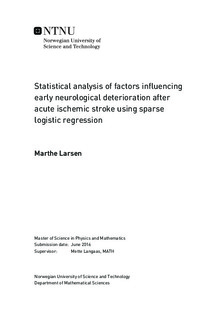Statistical analysis of factors influencing early neurological deterioration after acute ischemic stroke using sparse logistic regression
Master thesis
Permanent lenke
http://hdl.handle.net/11250/2402932Utgivelsesdato
2016Metadata
Vis full innførselSamlinger
Sammendrag
A total of 368 patients treated at the stroke unit at St. Olavs hospital in Trondheim were included in a study to analyze early neurological deterioration after acute ischemic stroke. Bad prognosis is associated with early neurological deterioration, and more research concerning the causes of early neurological deterioration is needed. In a preliminary analysis the time-dependent variables from the study were explored with unsupervised methods and quintile analysis. Principal component analysis and clustering were used to explore any possible groupings of the level of function measured with the European progression stroke study scale. The preliminary analysis led to using a binary response and different summary statistics for the time-dependent predictors. Potential factors influencing early neurological deterioration were analyzed with the lasso-penalized logistic regression method. Lasso regression uses a $l_1$-penalty to shrink parameters to zero, and preforms variable selection automatically. Also, the lasso has no limitations on the number of predictors and finds a sparse solution to complex problems. Lasso is a relatively new method and in particular developments towards statistical inference is still ongoing.
With the lasso method 22 predictors were included in the final model. Both variables measured on admission and time-dependent variables were estimated to be nonzero. The analysis also shows that both level and variability of the time-dependent predictors are important, so that monitoring patients closely the first few days after acute ischemic stroke is essential for the outcome. The penalty parameter controls the strength of the shrinkage and was chosen with cross-validation. Exact standard errors and confidence intervals for the regression parameters do not exist for the lasso method. Thus, inference about the regression parameters was performed using bootstrapping. The limitation of the lasso method is that it does not handle correlated variables very well, and the limitation is visualized and analyzed for the stroke data from Trondheim. In the field of medical statistics the lasso method has the potential to be very useful as it handles data with numerous predictors, and finds a good model for prediction.
